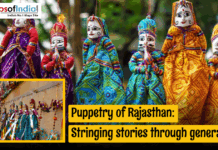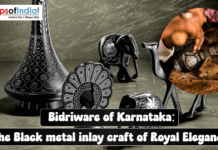Many toys in India are handmade, and people use them to remember their stories, pass on traditions and strengthen family ties. Before there were so many plastic toys, Indian children played with colorful toys made by hand from nature’s materials. The toys, from the lightest lac bangles to the fun wooden rattles, reflected the culture and talent of the region. Let us learn about some traditional toys of India, understand their background, their importance and how they have managed to impress generations.
A Glimpse into India’s Toy-Making Heritage
Making toys has been part of India’s culture for generations and continues to change over time. For years, many Indians have made toys and children have learned the craft from their parents and grandparents. Many times, these toys copy the local traditions, culture and routines, so they become storytellers in their own way.
It’s good to stress that Indian models are generally eco-friendly. People in crafts fields use local, biodegradable items such as wood, clay, cloth or lac. Most of these toys are not like mass-produced ones because they are safe, sustainable and made with natural dyes by hand.
Lac Bangles: A Celebration of Color and Culture
Even though they are jewelry, lac bangles are an important element of children’s games in some Indian communities. Many little girls have always been drawn to the colorful and sparkling pieces of jewelry. Lac, which comes from lac insects, is melted and shaped by skilled artisans into beautiful bangles.
Origin: Lac bangles are mostly made in Rajasthan and some areas of Andhra Pradesh and Bihar. Several streets in Jaipur are full of shops selling these painted items.
How They’re Made: Chekru bangles are made by first melting lac, adding natural colors and rolling the mixture around metal or wooden molds using a method called rawa. The glass beads, small mirrors or sequins are added to enhance the bangles.
Cultural Significance: During festivals, marriages and celebrations, people can usually be seen wearing lac bangles for their significance as well as how they look. Young girls see them as a link to womanhood and tradition, so they are not only decorations.
Wooden Rattles: A Baby’s First Friend
The wooden rattle ranks among the favored traditional toys because of its simplicity. They are usually the first toy a baby gets, and they are made to stimulate the baby’s senses, not only to make the child play.
Origin: You can find lovely wooden rattles being made in Varanasi (Uttar Pradesh), Channapatna (Karnataka) and Kondapalli (Andhra Pradesh).
How They’re Made: Rattles are made by artisans by carving them from neem, mango or hale-type woods. Most of these woods make use of natural oils that give various benefits, and their smoothness protects babies. Natural and safe colors such as red, green and yellow are painted on the bones, which usually come from vegetable dyes.
Cultural Significance: Lots of parents use rattles for both their gentle shaking and colorful boards, which help calm and stimulate their babies’ senses. A lot of traditional rattles are carved to resemble animals or birds, exposing children to nature at an early stage.
Channapatna Toys: The Pride of Karnataka
Channapatna in Karnataka is called the “Toy Town” of India for its famous tradition of making traditional wooden toys. People can instantly tell one of these toys by their shiny lacquered coating and bright shades.
History: During Tipu Sultan’s rule, Persian artisans were invited to Channapatna and they taught people about lacquered wooden toys. Over the years, people who made these items improved their craft.
Toy Types: You’ll find spinning tops, dolls, trains and puzzles in the line of toys created in Channapatna. Before being finished, every toy is molded with a lathe, given its shape and then a safe, natural lacquer is used to protect it.
Significance: They have a significance beyond giving children pleasure; they reflect old-fashioned sustainability and are an example of art blended with purpose. They are marked with a GI tag which maintains their honesty and uniqueness.
Clay Toys: The Humble Charm of Mud
Clay toys have been made in India for a very long time because of their earthy colors and simple designs. Various villages in China have distinctive ways of doing things, showing their own traditions and way of living.
Origin: Clay toys are largely associated with West Bengal, Tamil Nadu and Gujarat.
How They’re Made: Nearby earth is used to make the clay which is manually kneaded. After that, artisans shape the clay to make animals, fruits, smaller cooking sets and many other things and then they bake them in kilns. There are toys left as they are without paint which creates a rustic appearance, while others have a natural color scheme.
Cultural Significance: Agricultural activities, daily family rituals and village gods are often shown in traditional toys. From them, children discover about the people and community they belong to.
Puppets: Strings that Weave Tales
People in India watch puppet shows for enjoyment and to learn traditional lessons. Puppets have been used from Rajasthan’s desert sands in the north to Andhra Pradesh in the south to tell old stories and legends.
Types: Kathputli, an outstanding performance art from Rajasthan, is the one you probably know from its bright, wooden-headed puppets dressed in colorful clothing. Using leather, they make shadow puppets in Andhra Pradesh for the practice of Tholu Bommalata.
How They’re Made: Puppets are created using wood, cloth, and sometimes utilizing animal hide. Usually, artisans draw imaginative faces, dress their puppets in colorful outfits and add strings or rods for moving them.
Significance: Children learn about storytelling, music and drama when they interact with puppets. They are told about gods, heroes and local stories as they have fun.
Other Traditional Toys: A Celebration of Diversity
Like India’s cultures, its toy tradition is wide-ranging. There are some more audiobook suggestions below:
- Bamboo Toys: Assam and West Bengal make bamboo toys that are simple but still quite pretty, including flutes and tiny animals. Because bamboo is both flexible and strong, it works great in making toys.
- Palm Leaf Toys: Odisha and Tamil Nadu artists fold and weave palm leaves into small figures of birds, different animals and insects. There is a big increase in the use of these toys at temple festivals and fairs.
- Traditional Board Games: Here are some games: Chaupar (similar to Ludo), Pallanguzhi (from Tamil) and Ganjifa (a card game) improve a person’s planning, problem-solving and communication with others.
The Relevance of Traditional Toys Today
With so many plastic and battery-powered toys available, traditional Indian toys give something new and refreshing. People can use toys to use their imaginations, discover the beauty of nature and hold onto cultural examples. Today, lots of parents realize that these toys are good for the environment and help in early education.
Also, using traditional toys helps keep age-old crafts from dying out and helps those who still make such toys. Such toys are being advertised through exhibitions, online outlets and worldwide play groups.
Conclusion
Traditional toys in India are not only for play; they represent the nation’s art, traditions and history too. Everyone of these toys, bangles and instruments is a sign of the people and the stories behind a place in India. They show us a time when making things was crafty and creative and when play was natural and uncomplicated. Supporting these traditions guarantees that people will be charmed and encouraged by India’s heritage of making toys in the coming years.




